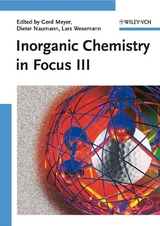Inorganic Chemistry in Focus III
Wiley-VCH (Verlag)
978-3-527-31510-9 (ISBN)
- Titel ist leider vergriffen;
keine Neuauflage - Artikel merken
Metal clusters are on the brink between molecules and nanoparticles in size. With molecular, nano-scale, metallic as well as non-metallic aspects, metal clusters are a growing, interdisciplinary field with numerous potential applications in chemistry, catalysis, materials and nanotechnology.This third volume in the series of hot topics from inorganic chemistry covers all recent developments in the field of metal clusters, with some 20 contributions providing an in-depth view. The result is a unique perspective, illustrating all facets of this interdisciplinary area:* Inter-electron Repulsion and Irregularities in the Chemistry of Transition Series* Stereochemical Activity of Lone Pairs in Heavier Main Group Element Compounds* How Close to Close Packing?* Forty-Five Years of Praseodymium Diiodide* Centered Zirconium Clusters* Titanium Niobium Oxychlorides* Trinuclear Molybdenum and Tungsten Cluster Chalcogenides* Current State of (B,C,N)-Compounds of Calcium and Lanthanum* Ternary Phases of Lithium with Main-Group and Late-Transition Metals* Polar Intermetallics and Zintl Phases along the Zintl Border* Rare Earth Zintl Phases* Structure-Property Relationships in Intermetallics* Ternary and Quaternary Niobium Arsenide Zintl Phases* The Building Block Approach to Understanding Main-Group-Metal Complex Structures* Cation-Deficient Quaternary Thiospinels* A New Class of Hybrid Materials via Salt Inclusion Synthesis* Layered Perrhenate and Vanadate Hybrid Solids* Hydrogen Bonding in Metal Halides* Syntheses and Catalytic Properties of Titanium Nitride Nanoparticles* Solventless Thermolysis* New Potential Scintillation Materials in Borophosphate Systems.With its didactical emphasis, this volume addresses a wide readership, such that both students and specialists will profit from the expert contributions.
Gerd Meyer studied chemistry at the Justus-Liebig University in Giessen under the supervision of Rudolf Hoppe. He gained his doctorate in 1976, and in 1980 worked with John D. Corbett at Iowa State University. In 1982 he gained his lecturing qualification in inorganic chemistry at Giessen, becoming a Full Professor at the University of Hanover in 1988. He subsequently moved to the same position at the University of Cologne in 1996. Professor Meyer's main research interests focus on solid-state and coordination chemistry of rare-earth elements and transition elements. Dieter Naumann studied chemistry at the Rheinisch-Westfaelische Technische Hochschule (RWTH) at Aachen. His diploma (1967) and doctoral theses (1969) were supervised by Martin Schmeisser. Research on perfluoroalkyl iodine compounds led to his lecturing qualification in inorganic chemistry at the University of Dortmund in 1975. From 1967 until 1989 he was a Professor in Dortmund, becoming a Full Professor of Inorganic and Analytical Chemistry at the University of Cologne in 1989. His main research interests are syntheses of fluoroorgano groups 10 to 18 element compounds. Lars Wesemann studied chemistry at the Rheinisch-Westfaelische Technische Hochschule in Aachen. His diploma and doctoral theses were supervised by Gerhard E. Herberich, and he gained the latter in 1990. After that he worked in Dietmar Seyferth's group at MIT for one year before returning to the RWTH Aachen. Independent research led him to his lecturing qualification in inorganic chemistry in 1997. He was a Professor of Inorganic Chemistry at the University of Cologne from 1999 until 2003, and is now a Full Professor at the University of Tübingen.
Inter-Electron Repulsion and Irregularities in the Chemistry of Transition Series
Stereochemical Activity of Lone Pairs in Heavier Main Group Element Compounds
How Close to Close Packing?
Forty-Five Years of Praseodymium Diiodide, PrI2
Centered Zirconium Clusters: Mixed-Halide Systems
Titanium Niobium Oxychlorides: Ligand Combination Strategy for the Preparation of Low-Dimensional Metal Cluster Materials
Trinuclear Molybdenum and Tungsten Cluster Chalcogenides: From Solid State to Molecular Materials
Current State of (B,C,N)-Compounds of Calcium and Lanthanum
Compositional, Structural and Bonding Variations in Ternary Phases of Lithium with Main-Group and Late-Transition Metals
Polar Intermetallics and Zintl Phases along the Zintl Border
Rare Earth Zintl Phases: Novel Magnetic and Electronic Properties
Understanding of Structure-Forming Factors and Theory-Guided Exploration of Structure-Property Relationschips in Intermetallics
Ternary and Quaternary Niobium Arsenide Zintl Phases
The Building Block Approach to Understanding Main-Group-Metal Complex Structures - More than just "Attempting to Hew Blocks with a Razor"
Cation-Deficient Quaternary Thiospinels
A New Class of Hybrid Materials via Salt Inclusion Synthesis
Layered Perrhenate and Vanadate Hybrid Solids: On the Utility of Structural Relationships
Hydrogen Bonding in Metal Halides: Lattice Effects and Electronic Distortions
Syntheses and Catalytic Properties of Titanium Nitride Nanoparticles
Solventless Thermolysis: A Possible Bridge Between Crystal Structure and Nano Synthesis?
New Potential Scintillation Materials in Borophosphate Systems
"...recommended both to inorganic chemists and solid-state physicists." ( Journal of the American Chemical Society , January 31, 2007)
| Erscheint lt. Verlag | 20.7.2006 |
|---|---|
| Sprache | englisch |
| Maße | 170 x 240 mm |
| Gewicht | 715 g |
| Themenwelt | Naturwissenschaften ► Chemie ► Anorganische Chemie |
| Schlagworte | Anorganische Chemie • Chemie • Chemistry • Festkörperchemie • Inorganic Chemistry • Materials Science • Materialwissenschaften • solid state chemistry |
| ISBN-10 | 3-527-31510-1 / 3527315101 |
| ISBN-13 | 978-3-527-31510-9 / 9783527315109 |
| Zustand | Neuware |
| Haben Sie eine Frage zum Produkt? |
aus dem Bereich




